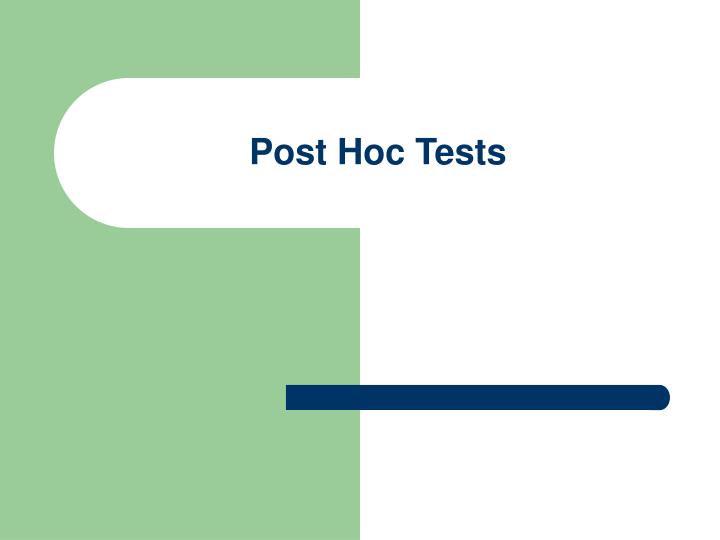A Preferred Post Hoc Test is Because Its Presentation is Easy to Interpret
![]() Download
Download

Skip this Video
Loading SlideShow in 5 Seconds..
Post Hoc Tests PowerPoint Presentation


Post Hoc Tests
Download Presentation
Post Hoc Tests
- - - - - - - - - - - - - - - - - - - - - - - - - - - E N D - - - - - - - - - - - - - - - - - - - - - - - - - - -
Presentation Transcript
-
Post Hoc Tests
-
What is a Post Hoc Test? • Review: • Adjusting Alpha Level • Multiple A Priori Comparisons • What makes a test Post Hoc? • Many tests could be Post Hoc… But, there are set Post Hoc tests
-
Studentized Range Statistic q
-
Studentized Range Statistic q Independent Groups Largest mean Smallest mean Example Fail to Reject Note: arrange means in ascending order! = 3.77 critical value
-
Studentized Range Statistic q • q's can tell us where differences are (more specific than F) • Solving q's is just like solving t's • But we solve a lot of q's… can we speed things up?
-
Solving for the Smallest Significant Difference Example = 3.77 critical value
-
Solving for the Smallest Significant Difference • Solving for the smallest significant difference will help us make quicker comparisons • But we still need a way to organize things nicely…
-
Newman-Kewls smallest difference required was 6.61 smallest significant difference If 2 steps Example
-
A Better Newman-Kewls Example Example
-
A Better Newman-Kewls Example Read Right to Left UNTIL 1. The row is completed 2. A nonsignificant difference is found 3. Reaching a column which was nonsignificant on the previous row
-
Newman-Kewls Summarized • Newman-Kewls tables help organize your q's • When doing a set of post hoc comparisons it's best to use a Newman-Kewls table
-
Unequal N's Tukey-Kramer Replace with
-
Unequal N's Behrens-Fisher * * Each particular pairing of means must be examined with a different critical value and their own Thus, the smallest significant difference will vary even for a given
-
A Problem with q So Far… • Why are we doing q's anyway? Why not do t's instead? • But is q really controlling our alpha level? NO! Using q's will give use more Type I Errors
-
Trying to fix q Tukey's HSD Tukey's WSD N-K except If there are 4 means, all differences are treated as 4 steps. r = # of steps between the two means to be compared. What Happens to Alpha Level? Power?
-
Tukey's HSD and WSD Use Tukey's WSD, not normal method for q
-
Back to Post Hoc in General • What is a post hoc test again? • What are the real issues with Post Hoc tests? Alpha and Power… • q is just one type of post hoc (one way to balance alpha and power), what are others?
-
Dunnett's Control vs. Treatment run standard and use or, solve for critical difference (CV) Example Go to Table for * Pros…? Cons…?
-
Sheffé's Test Linear contrast To evaluate MS(contrast) 1) consult F table and find critical value F.05 (k-1, dferror) (CV) F = MS(error) 2) multiply CV by (k-1). (new CV) It sets the family-wise Type-I Error rate ( in our case) for ALL possible linear contrasts, not merely the pair-wise comparisons. Don't use when only doing pair-wise, because it will be overly conservative.
-
Post Hoc Summary • When to use what… • q in most situations… but use Tukey's WSD for critical value • Put things in a Newman-Kewls table • when N's are unequal, use Tukey's correction • Dunnett's when you have one control and multiple treatments • Sheffé's ONLY when you are doing complex comparisons (i.e., contrasts)
-
Post Hoc Summary • Be aware of the alpha level and power issues… • Why can't we have a perfect test (i.e., low alpha level and high power)? • How does Tukey's WSD and HSD relate to this? • How does Dunnett's relate to this? • How does Sheffé's relate to this?
Source: https://www.slideserve.com/cherie/post-hoc-tests
0 Response to "A Preferred Post Hoc Test is Because Its Presentation is Easy to Interpret"
Post a Comment